Offutt Air Force Base
| Offutt Air Force Base | |
|---|---|
| Part of Air Combat Command (ACC) | |
| Located near: Omaha, Nebraska | |
|
Offutt Air Force Base | |
| Coordinates | 41°07′10″N 095°54′31″W / 41.11944°N 95.90861°W |
| Site information | |
| Controlled by |
|
| Site history | |
| Built | 1918 |
| In use | 1948–present |
| Garrison information | |
| Garrison |
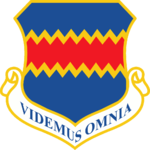 55th Wing |
| Airfield information | |||||||||||
|---|---|---|---|---|---|---|---|---|---|---|---|
| IATA: OFF – ICAO: KOFF – FAA LID: OFF | |||||||||||
| Summary | |||||||||||
| Elevation AMSL | 1,052 ft / 321 m | ||||||||||
| Coordinates | 41°07′10″N 095°54′31″W / 41.11944°N 95.90861°WCoordinates: 41°07′10″N 095°54′31″W / 41.11944°N 95.90861°W | ||||||||||
| Website | www.offutt.af.mil | ||||||||||
| Map | |||||||||||
 KOFF Location of Offutt Air Force Base | |||||||||||
| Runways | |||||||||||
| |||||||||||
| Offutt AFB, Nebraska | |
|---|---|
| CDP | |
 Location of Offutt AFB, Nebraska | |
 U.S. Census Map | |
| Country | United States |
| State | Nebraska |
| County | Sarpy |
| Area | |
| • Total | 4.3 sq mi (11 km2) |
| • Land | 4.2 sq mi (11 km2) |
| • Water | 0.1 sq mi (0.3 km2) |
| Elevation | 988 ft (301 m) |
| Population (2000) | |
| • Total | 8,901 |
| • Density | 2,100/sq mi (800/km2) |
| Time zone | Central (CST) (UTC-6) |
| • Summer (DST) | CDT (UTC-5) |
| FIPS code | 31-35945[1] |
| GNIS feature ID | 0837659[2] |

U.S. Strategic Command Headquarters
.jpg)
Offutt Air Force Base (IATA: OFF, ICAO: KOFF, FAA LID: OFF) is a U.S. Air Force installation near Omaha, and lies adjacent to Bellevue in Sarpy County, Nebraska. It is the headquarters of the U.S. Strategic Command (USSTRATCOM), the Air Force Weather Agency, and the 55th Wing (55 WG) of the Air Combat Command (ACC), the latter serving as the host unit.
Aviation use at Offutt began in September 1918 during World War I as an Army Air Service balloon field.[3] It was renamed in honor of World War I pilot and Omaha native 1st Lt. Jarvis Offutt in 1924.
Offutt AFB's legacy includes the construction of the first two bombers to drop atomic bombs and over 40 years as the headquarters for the former Strategic Air Command (SAC) and home for its associated ground and aerial command centers for the U.S. in case of nuclear war during the Cold War. The population was 8,901 at the 2000 census.
Overview
Offutt Air Force Base is the host station for the 55th Wing (55 WG), the largest wing of the United States Air Force's Air Combat Command. Additionally, the base is home to many significant associate units, including US Strategic Command Headquarters, the Air Force Weather Agency, the Omaha operating location of the Defense Finance and Accounting Service, and many others.
Units
55th Wing
The 55 Wing (WG) mission is to provide dominant intelligence, surveillance, reconnaissance; electronic attack; command and control; and precision awareness to national leadership and warfighters across the spectrum of conflict any time, any place. One of the wing's units, the 55th Operations Group, operates 46 aircraft, including 13 models of seven different types.
The 55th Wing is composed of five groups at Offutt AFB and at various locations worldwide:
- 55th Operations Group
- The 55th Operations Group, Air Combat Command's(ACC) largest group, has operational control over 11 squadrons[4] and two detachments worldwide. The group consists of approximately 3,200 personnel. It employs 46 aircraft, including 13 models of seven different types. The 55th Operations Group uses the tail code OF for its aircraft
- 38th Reconnaissance Squadron (RC-135)
- 343d Reconnaissance Squadron (RC-135)
- 45th Reconnaissance Squadron (OC-135, RC-135, TC-135, WC-135)
- 82d Reconnaissance Squadron (RC-135)
- Operates from Kadena AB, Japan
- 95th Reconnaissance Squadron (RC-135)
- Operates from: RAF Mildenhall, England
- Operates from: Souda Bay, Crete
- 55th Electronic Combat Group
- The 55th Electronic Combat Group, stationed at Davis-Monthan AFB, is an operations group and geographically separated unit (GSU) of the 55th Wing. It consists of 5 squadrons, 3 flying squadrons, 1 support squadron and 1 maintenance squadron. All 3 flying squadrons utilize various models of the EC-130 aircraft.
- 41st Electronic Combat Squadron (ECS)
- 42d Electronic Combat Squadron (ECS)
- 43d Electronic Combat Squadron (ECS)
- 755th Operations Support Squadron (OSS)
- 755th Aircraft Maintenance Squadron (AMXS)
- 55th Maintenance Group
- The 55th Maintenance Operations Squadron provides centralized direction of all maintenance staff functions providing support to world-wide aircraft reconnaissance missions.
- 55th Mission Support Group
- The 55th Mission Support Group provides vital mission support for Offutt AFB through engineering, security, mission support, services, supply, transportation, contracting & deployment readiness programs.
- 55th Communications Group
- The 55th Communications Group provides worldwide command, control, communications and computer (C4)[5] systems, information management and combat support to warfighting and national leadership. It also provides communications technology and support to the 55th Wing and 44 tenant units.
- 55th Medical Group
- The 55th Medical Group serves 28K enrolled patients with extensive outpatient clinic capabilities, and ancillary support.
United States Strategic Command
Offutt AFB is the headquarters of United States Strategic Command (USSTRATCOM) which is one of the nine Unified Combatant Commands of the United States Department of Defense (DoD). USSTRATCOM was established in 1992 as a successor to Strategic Air Command (SAC).
It is charged with space operations (such as military satellites), information operations (such as information warfare), missile defense, global command and control, intelligence, surveillance, and reconnaissance (C4ISR), global strike and strategic deterrence (the United States nuclear arsenal), and combating weapons of mass destruction.
557th Weather Wing
The 557th Weather Wing, formerly the Air Force Weather Agency, is headquartered at Offutt AFB. It is the lead weather center of the United States Air Force. AFWA enhances the combat capability of the United States by delivering timely, accurate, and reliable environmental situational awareness worldwide to the Air Force, the Army, joint warfighters, Unified Combatant Commands, the national intelligence community, and the Secretary of Defense.
History
For over a century, Offutt AFB has played a key role in American military history. From its beginnings as Fort Crook in the late 19th century, Offutt has adapted to the defense needs of the United States. The historical significance of Offutt is a source of pride for military and community members alike.
Offutt AFB is named in honor of First Lieutenant Jarvis Jennes Offutt (26 October 1894 – 13 August 1918). The first native of Omaha to become a casualty in World War I, Lieutenant Offutt died of injuries sustained when his SE-5 fighter crashed during a training flight near Valheureux, France. The airfield portion of Fort Crook was designated Offutt Field on 10 May 1924.[6]
Fort Crook
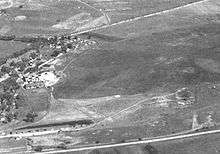
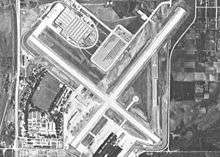
Offutt's great heritage began with the commissioning by the War Department in 1890 of Fort Crook. Located some 10 miles south of Omaha and two miles west of the Missouri River, the fort was constructed between 1894 and 1896. The fort's namesake was Major General George Crook,[7] a Civil War veteran and Indian fighter.
It was first used as a dispatch point for Indian conflicts on the Great Plains. Troops from Fort Crook fought during the Spanish–American War when the 22nd Regiment under Charles A. Wikoff was dispatched to Cuba. The regiment suffered heavy casualties in the Battle of El Caney. Only 165 of the 513 regiment members survived with most succumbing to tropical diseases after the battle.[8]
The oldest surviving portion of Fort Crook is the parade grounds and surrounding red brick buildings that were constructed between 1894–96. These structures are still in active use today as squadron headquarters, living quarters for high-ranking generals (Generals Row), and Nebraska’s oldest operational jail.
Offutt Field
In 1918, the 61st Balloon Company of the Army Air Corps was assigned to Fort Crook at the close of World War I, which performed combat reconnaissance training. In the spring of 1921, the plowing, leveling, and seeding of 260 acres of land at Fort Crook created an airfield suitable for frequent takeoffs and landings and as a refueling stop for mail and transcontinental flights. The first permanent aircraft hangars were completed in 1921. Other known organizations assigned to the field were the 74th Balloon Company in November 1918; 60th Balloon Company in December 1918.
On 6 May 1924, the airfield was officially named "Offutt Field". The field accommodated interim reserve flying training and regular Post Office Department airmail flights during the 1920s and 1930s; a small detachment of enlisted men (detached service) from Marshall Field and Fort Riley, Kansas, constituted the only military presence on the field between 1935–1940.
Glenn L. Martin Bomber Plant
In 1940 as American involvement in World War II loomed, the Army Air Corps chose Offutt Field as the site for a new bomber plant that was to be operated by the Glenn L. Martin Company. The plant's construction included a two-mile (3 km)-long concrete runway, six large hangars, and a 1,700,000-square-foot (160,000 m2) aircraft-assembly building.
Production switched to B-29 Superfortress very heavy bombers in 1944, and 531 Superfortresses were produced before the end of World War II. Among these were the Enola Gay and Bockscar, the B-29's that dropped the first atomic weapons to be used in a military action (against the cities of Hiroshima and Nagasaki, Japan).
Production ended on 18 September 1945, when the last B-29 rolled out of the assembly building. With the manufacturing plant's closure, custody of the airfield and ground facilities were assumed by the 4131st Army Air Force Base Unit, Air Materiel Command.
Postwar use

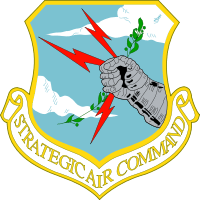
In the initial months after the end of World War II, Offutt was used by the 2474th Separation Processing squadron to demobilize service members out of the armed forces after their return from overseas duty. In June 1946, the Army Air Force re-designated Fort Crook and the Martin-Nebraska facilities as Offutt Field. It became the headquarters for the Air Defense Command Second Air Force on 6 June. In 1947, the airfield opened for operational use, with the 381st Bombardment Group being assigned to the field with one squadron of B-29 Superfortresses, although the facility remained primarily a separation center.
The newly established United States Air Force took control of the facility in September 1947, and on 13 January 1948 it was renamed Offutt Air Force Base. Later that same year, on 26 September, the 3902nd Air Base Group (later Wing) became the host unit at Offutt.[9]
Strategic Air Command
At one minute past midnight, on 9 November 1948, Offutt gained international prominence when it became the host base for Headquarters Strategic Air Command, which was moved from Andrews AFB, Maryland. Secretary of the Air Force Stuart Symington chose to locate the Air Force's crucial long-range atomic strike force at Offutt primarily because the base was centrally located on the North American continent, placing it well beyond the existing range of long-range, nuclear-armed bombers to (then) stay safely out of range of hostile missiles or bomber aircraft.
Offutt's population and facilities grew dramatically to keep pace with the increased operational demands during the Cold War. Several new dormitories and more than 2,000 family housing units – built in the late 1950s and 1960s under incremental Wherry and Capehart projects – quickly replaced the old quarters of Fort Crook. Headquarters SAC moved from the Martin-Nebraska complex to Building 500 in 1957, and new base facilities in the 1960s and 1970s included a hospital, main exchange, commissary, and library.
During the late 1950s Offutt housed a Royal Air Force facility for servicing Avro Vulcans, which visited the air base frequently while on exercise with SAC.[10]
Operational use of Offutt Air Force Base included the basing of alert tankers in the late 1950s and 1960s, support for intercontinental ballistic missile sites in Nebraska and Iowa in the 1960s, and worldwide reconnaissance from the mid-1960s to the present.
To provide air defense of the base, the United States Army established the Offutt AFB Defense Area and Nike-Hercules Surface-to-air missile sites were constructed during 1959. Sites were located near Cedar Creek, Nebraska (OF-60) 40°59′00″N 096°05′28″W / 40.98333°N 96.09111°W, and Council Bluffs, Iowa (OF-10) 41°13′47″N 095°41′58″W / 41.22972°N 95.69944°W. They were operational between November 1960 and March 1966. The missiles were operated by the 6th Battalion, 43d Artillery.[11]
During the Cold War, a general and various support personnel from the base were airborne 24-hours a day on an EC-135 from 3 February 1961 to 24 July 1990 in Operation Looking Glass, creating an airborne command post in case of war. Operation Looking Glass carried out its mission without any mishaps or incidents during its 29 years of existence.
The 3902d Air Base Wing was inactivated on 1 March 1986, and the 55th Strategic Reconnaissance Wing assumed host-unit responsibilities for Offutt. Increased defense spending during the 1980s brought additional operational improvements to Offutt, including the Bennie Davis Aircraft Maintenance Hangar, and a new command center for Headquarters SAC.
U.S. Strategic Command
Offutt again faced monumental changes in 1992 when the easing of world tensions allowed the United States to reorganize the Air Force. The Strategic Air Command (SAC) was inactivated on 1 June, succeeded by the U.S. Strategic Command (USSTRATCOM), a Unified Combatant Command of the Department of Defense. The 55th Strategic Wing then became the 55th Wing, under the newly created Air Combat Command.
In 1998, the Strategic Air and Space Museum moved 30 miles (48 km) southwest to Ashland, just off Interstate 80, midway between Omaha and Lincoln.
In 2005, Offutt began several major renovations. The on-base Wherry housing area was demolished for replacement with new housing. A new fire house, AAFES mini-mall, and U.S. Post Office were completed in 2006. Additionally, the Air Force Weather Agency broke ground on a new facility which was completed in 2008.
President Bush Offutt Conference on 11 September

On 11 September 2001, President George W. Bush conducted one of the first major strategy sessions for the response to the September 11 attacks from a bunker at the base.
Bush, who was in Florida at the Emma Booker Elementary School in Sarasota[12] at the time of the attacks, first flew from Sarasota-Bradenton International Airport to Barksdale AFB in Louisiana and then to Offutt en route back to Washington, DC. Bush arrived at 2:50 pm (Eastern), conducted a video conference in an underground command bunker and left for Washington, DC at 4:30 pm.[12]
Air Force One left Barksdale AFB for Offutt AFB around 1:30pm.[13] Air Force One entourage was pared down to a few essential staffers such as Ari Fleischer, Andrew Card, Karl Rove, Dan Bartlett, Brian Montgomery, and Gordon Johndroe, plus about five reporters.[14] During the flight, Bush remained in “continuous contact” with the White House Situation Room and Vice-President Dick Cheney.[15]
Air Force One landed at Offutt shortly before 3:00 pm[12] At 3:06, Bush passed through security to the US Strategic Command Underground Command Center (41°06′50″N 095°55′04″W / 41.11389°N 95.91778°W)[12] and was taken into an underground bunker designed to withstand a nuclear blast.[15] There, he held a teleconference call with Vice-President Cheney, National Security Advisor Condoleezza Rice, Defense Secretary Donald Rumsfeld, Deputy Secretary of State Richard Armitage, CIA Director Tenet, Transportation Secretary Norman Mineta, and others.[15] The meeting lasted about an hour. Rice recalled that during the meeting, Tenet told Bush, "Sir, I believe it’s al-Qaeda. We’re doing the assessment but it looks like, it feels like, it smells like al-Qaeda."[16] The White House staff was preparing for Bush to address the nation from the Offutt bunker, but Bush decided instead to return to Washington.[15]
Air Force One left Offutt around 4:30pm.[12]
Previous names
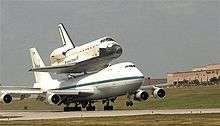
- Fort George Crook, 3 Mar 1891
- Flying Field, Fort George Crook, 1920
- Offutt Field, 6 May 1924
Major commands to which assigned
- Seventh Corps Area, United States Army, 1920
- Army Air Forces Materiel Command, 13 Oct 1942
- Army Air Forces Materiel and Services Command, 17 lui 1944
- Redesignated: AAF Technical Service Comd, 31 Aug 1944
- Redesignated: Air Technical Service Command, 1 lui 1945
- Redesignated: Air Materiel Command, 9 Mar 1946
- : The United States Army Seventh Service Command exercised overall jurisdiction until 11 June 1946
- Air Defense Command, 11 June 1946
- Strategic Air Command, 1 Oct 1948
- Air Combat Command, 1 June 1992
Major units assigned
|
|
- 1st Air COMM Group, then 1st Air Comm Wing, then 1st Air Information Systems Wing at least August 1984 - April 1988 I know because I was there and this was my unit. The Squadrons were 390th, 1850th, 1851st, and the 1853rd.
Intercontinental ballistic missile facilities
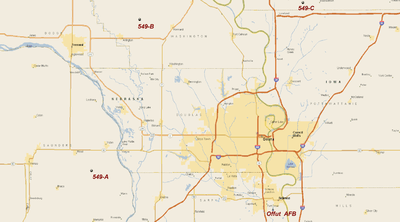
The 549th Strategic Missile Squadron operated three SM-65D Atlas ICBM sites (1 October 1960 – 15 December 1964). Each site was composed of three missile silos (9 total).
- 549-A, 3.4 mi SE of Mead, NE 41°11′37″N 096°26′23″W / 41.19361°N 96.43972°W
- 549-B, 3.6 mi NE of Arlington, NE 41°29′17″N 096°17′59″W / 41.48806°N 96.29972°W
- 549-C, 4.3 mi SE of Missouri Valley, IA 41°31′15″N 095°49′09″W / 41.52083°N 95.81917°W
Beginning in 1958, the Army Corps of Engineers began planning for the sites, and construction began in 1959. The construction project was completed on 28 July 1960. In April and May 1961, the three complexes became the last Atlas D missiles to go on alert.
The missiles were manned by the 549th Strategic Missile Squadron which was activated on 1 October 1960. The squadron began to phase down with the inactivation of the Atlas-D on 1 October 1964, and was inactivated 14 December 1964. Confusingly, the squadron was originally the 566th but on 1 July 1961 SAC swapped designators with the 549th at F.E. Warren AFB. The 549th SMS was under the 385th Strategic Aerospace Wing.
Today, site "A" is owned by the University of Nebraska, and being leased to a company for ranching and storage. It is also used by the Nebraska National Guard as a training site for many years, mostly for military police K-9 training. Site "B" is remarkably intact and in use for agricultural storage. Site "C" has been demolished, with only the access roads remaining.
Whistleblower suit
In May 2011, base civilian employee George Sarris successfully settled with the government over claims that he was subjected to retaliation for talking to the media in 2008 about poor maintenance of RC-135 aircraft at the base. After Sarris' allegations appeared in the Kansas City Star, base officials revoked his security clearance and reassigned him to menial duties. Later investigations by the government substantiated many of Sarris' claims. As part of the settlement, the USAF agreed to pay Sarris his full salary until he retires in 2014 and paid $21,000 of his attorney's fees.[17] After retiring, Sarris published a book titled, Cowardice in Leadership – A Lesson in Harassment, Intimidation, and Reprisals.[18]
General's Row
Most of the high-ranking officials at Offutt live on General's Row, a row of 4-story duplexes that were built in 1895.
Radio Transmissions
Because of its central position in the US, radio traffic to and from Offutt is often heard by shortwave listeners on 11175 kHz.[19]
Offutt in popular culture
Offutt was brought to popular attention during its SAC period when the command was depicted in the 1955 film Strategic Air Command starring Jimmy Stewart, the 1963 film A Gathering of Eagles starring Rock Hudson, and 1964's Fail-Safe starring Henry Fonda (which not only claimed to show portions of the base but also a nearby Omaha neighborhood) and Dr. Strangelove or: How I Learned to Stop Worrying and Love the Bomb starring Peter Sellers (which depicts a nuclear first strike from a mad general at the fictional Burpelson Air Force Base).
Offutt appeared in the Star Trek episode "Tomorrow Is Yesterday" (identified as 'the Omaha installation'), when a fighter pilot stationed there detects the approaching USS Enterprise and is transported aboard.
The Dale Brown novel Plan of Attack saw nuclear missiles launched by Russian bombers attacking multiple bomber bases all over the U.S, including Offutt, which is destroyed by four Kh-15 (AS-17 Kickback) missiles. Only one Boeing E-4 NEACP escapes in time, and the officials of the Eighth Air Force and STRATCOM are eliminated in the process. Pat Frank's iconic Cold War novel Alas, Babylon (1959) has Air Force Colonel Mark Bragg, the brother of the protagonist Randy Bragg, stationed at Offutt.
Offutt is also mentioned in Strike Three, a post-apocalyptic novel, by Joy V. Smith.
Geography
Offutt Air Force Base is located at 41°06′49″N 95°55′42″W / 41.11361°N 95.92833°W.[20]
According to the United States Census Bureau, the base has a total area of 4.3 square miles (11.3 km²), of which, 4.2 square miles (10.9 km²) of it is land and 0.1 square miles (0.4 km²) of it (3.22%) is water.
Demographics
As of the census[1] of 2000, there were 8,901 people, 2,304 households, and 2,255 families residing on the base. The population density was 2,113.1 people per square mile (816.3/km²). There were 2,429 housing units at an average density of 576.6/sq mi (222.8/km²). The racial makeup of the base was 78.0% White, 10.4% Black or African American, 0.7% Native American, 2.7% Asian, 0.3% Pacific Islander, 3.6% from other races, and 4.3% from two or more races. Hispanic or Latino of any race were 7.4% of the population.
There were 2,304 households out of which 79.1% had children under the age of 18 living with them, 90.5% were married couples living together, 5.3% had a female householder with no husband present, and 2.1% were non-families. 1.9% of all households were made up of individuals and none had someone living alone who was 65 years of age or older. The average household size was 3.61 and the average family size was 3.64.
On the base the population was spread out with 41.9% under the age of 18, 16.8% from 18 to 24, 39.7% from 25 to 44, 1.4% from 45 to 64, and 0.1% who were 65 years of age or older. The median age was 22 years. For every 100 females there were 105.4 males. For every 100 females age 18 and over, there were 109.7 males.
The median income for a household on the base was $36,742, and the median income for a family was $36,619. Males had a median income of $25,391 versus $21,593 for females. The per capita income for the base was $11,580. About 4.4% of families and 5.6% of the population were below the poverty line, including 7.1% of those under age 18 and none of those age 65 or over.
See also
- Nebraska World War II Army Airfields
- SAC Elite Guard
- David Wade, Strategic Air Command chief of staff at Offutt in middle 1950s
References
- 1 2 "American FactFinder". United States Census Bureau. Archived from the original on 11 September 2013. Retrieved 2008-01-31.
- ↑ "US Board on Geographic Names". United States Geological Survey. 2007-10-25. Retrieved 2008-01-31.
- ↑ World War I Group, Historical Division, Special Staff, United States Army, Order of Battle of the United States Land Forces in the World War (1917–1919)
- ↑ "Units". www.offutt.af.mil. Retrieved 2016-11-21.
- ↑ "Department of Defense Dictionary of Military and Associated Terms" (PDF). www.dtic.mil/. Pentagon. Retrieved 8 May 2015.
- ↑ "History of Offutt Air Force Base" (PDF). Retrieved 8 May 2015.
- ↑ Gannett, Henry (1905). The Origin of Certain Place Names in the United States. Govt. Print. Off. p. 129.
- ↑ "Corporal Elmore Nelson". Emmitsburg Area Historical Society Retrieved on January 11, 2007.
- ↑ "MAJOR GENERAL A.J. BECK". Air Force e-Publishing. Archived from the original on 11 April 2008. Retrieved 2008-04-27.
- ↑ "[1.0] Vulcan Development". AirVectors. Retrieved 2010-03-17.
- ↑ Lincoln Air Force Base Online Museum
- 1 2 3 4 5 Cline, Austin. "September 11, 2001: Timeline of Events". About.com Guide. Archived from the original on 18 May 2015. Retrieved 11 September 2006.
- ↑ "Offutt Air Force Base". Retrieved 8 May 2015.
- ↑ Kohn, David. "Bush's Press Secretary Live-Tweets 9/11 From His Perspective". mashable.com. Retrieved 8 May 2015.
- 1 2 3 4 Langely, William. "Revealed: what really went on during Bush's 'missing hours". The Telegraph. Retrieved 8 May 2015.
- ↑ Kohn, David. "Bush On 9/11: Moment To Moment". CBS News. Retrieved 8 May 2015.
- ↑ McGraw, Mike. "Air Force whistleblower settles claims". Kansas City Star. Retrieved 8 May 2015.
- ↑ Sarris, George. "Cowardice in Leadership". Retrieved 8 May 2015.
- ↑ USAF High Frequency Global Communications System
- ↑ "US Gazetteer files: 2010, 2000, and 1990". United States Census Bureau. 2011-02-12. Retrieved 2011-04-23.
Other sources
-
 This article incorporates public domain material from the Air Force Historical Research Agency website http://www.afhra.af.mil/.
This article incorporates public domain material from the Air Force Historical Research Agency website http://www.afhra.af.mil/. -
 This article incorporates public domain material from the United States Government document "Offutt Air Force Base".
This article incorporates public domain material from the United States Government document "Offutt Air Force Base". - Maurer, Maurer. Air Force Combat Units of World War II. Washington, D.C.: U.S. Government Printing Office 1961 (republished 1983, Office of Air Force History, ISBN 0-912799-02-1).
- Ravenstein, Charles A. Air Force Combat Wings Lineage and Honors Histories 1947–1977. Maxwell Air Force Base, Alabama: Office of Air Force History 1984. ISBN 0-912799-12-9.
- Mueller, Robert, Air Force Bases Volume I, Active Air Force Bases Within the United States of America on 17 September 1982, Office of Air Force History, 1989
External links
| Wikimedia Commons has media related to Offutt Air Force Base. |
- US Strategic Command, official web site
- Offutt AFB history at Strategic-Air-Command.com
- Offutt AFB at GlobalSecurity.org
- The short film Air Force Special Film Project 416,"Power of Decision" (1958) is available for free download at the Internet Archive
- FAA Airport Diagram (PDF), effective December 8, 2016
- FAA Terminal Procedures for OFF, effective December 8, 2016
- Resources for this U.S. military airport:
- FAA airport information for OFF
- AirNav airport information for KOFF
- ASN accident history for OFF
- NOAA/NWS latest weather observations
- SkyVector aeronautical chart for KOFF
- Historic American Engineering Record (HAER) No. NE-9-M, "Offutt Air Force Base, Strategic Air Command Headquarters & Command Center, Headquarters Building, 901 SAC Boulevard, Bellevue, Sarpy County, NE", with extensive additional material such as:
- HAER No. NE-9-P, "Offutt Air Force Base, Glenn L. Martin-Nebraska Bomber Plant, Building A, 711 Nelson Drive, Bellevue, Sarpy County, NE"



